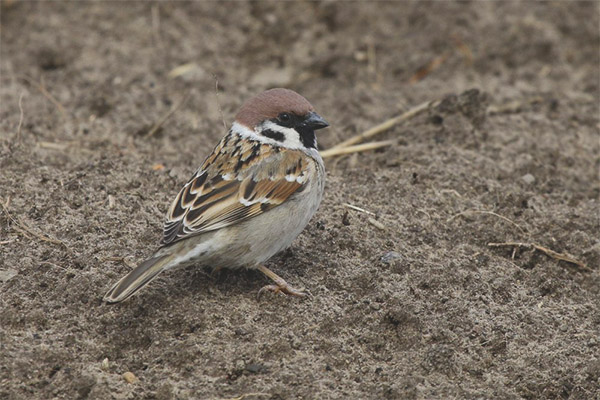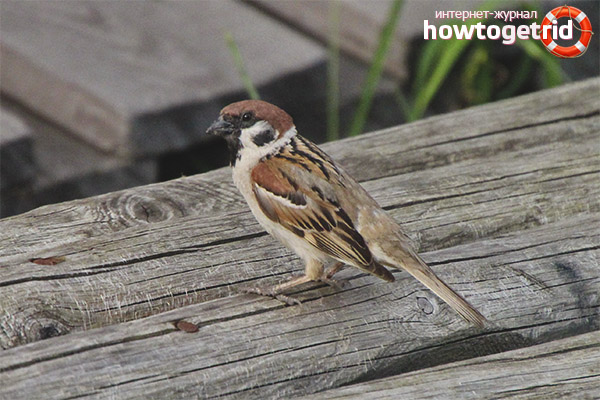The content of the article
Field sparrows are ranked as a sparrow family, respectively. They belong to the closest relatives of house birds. But by their natural features are not so dependent on people, preferring to avoid them. You can meet field representatives of the group on the outskirts of the city, as well as in sparsely populated areas or completely abandoned areas. It is important for them that nearby there are cereal crops, as well as gardens or vineyards. By their natural features, individuals prefer to live in a bright area, steppes and among shrubs.
Description
- Bird on the body does not have large dimensions. In length it grows up to a maximum of 16 cm with a body weight of 30 grams. (maximum value). If we compare this species of sparrows with house birds, we can say the following. They are not tied to human activity, and therefore may exist in uninhabited territories.
- Individuals of male and female sex are pigmented in identical tones.Regardless of the season of the year, this coloring will be modified only to a small extent. The upper part of the head is pigmented with chestnut. The cheeks and upper feathers on the wings are whitish. There is a distinct black spot on the cheeks.
- In the area behind the neck there is a so-called white necklace. It may be intermittent, with a chestnut tint. The neck is famous for having a black mark that does not descend onto the rib cage. The upper part of the body is painted red with brown, on the pink there are oblong stripes.
- The area above the tail is ocher with a light brown tone. The lower part of the body is whitish, there are patches of ocher hue. The same color comes on the sides of the calf. The wings are brownish, dark, with a characteristic light brown plum. On bends of wings there is a whitish mark. The tail is brown-brown, its edges are painted ocher. The beak is pigmented with black, brown iris, beige-pink paws.
- Young in their coloring is quite faded. He has no black feathers, instead there are brown-gray shades. The bill is also brown, the edges are yellowish, as well as the corners of the mouth.Field representatives differ from house sparrows in that the top of the head has a chestnut color. The individuals have black spots on the cheeks, and there is no difference in gender.
- From other representatives of the sparrow family, for example, individuals with black brisket, the field sparrow is distinguished by a bright back. These birds have a unique feature to look harmonious with their miniature size and short tail.
- As for the voice of these feathered relatives, their exclamations are somewhat similar to the voice of house sparrows. But it is sharper and more sonorous, there is no softness. If you briefly try to convey the cries, then they sound like a “cop,” “chip,” “tsvi.” These sounds can be alternated or pronounced separately.
Habitat
- Individuals are more common in the territory of our country. They live everywhere, but rarely occur in the Arctic zone. They are closer to the subarctic. As for the choice of landscape, then live from the taiga to the highlands. They are found in arid steppes and deserts.
- Quickly adapt to different climatic conditions.According to its natural number, field sparrows are larger than brownies. But this is due to the vast area in which these birds prefer to settle.
- Considering the accumulation of birds in cities, we can say that they live exclusively on the outskirts. They do not come close to high-rise buildings, they are not found in parks and squares.
Lifestyle
- Birds are sedentary, they do not like to wander from one place to another. Only populations living in the far north can go to other warm places for the winter period. These birds live in couples, do not form colonies during nesting, they keep apart.
- Abandoned stone buildings or hollows, as well as mink and former nests of storks are chosen as the location for housing construction. Under the nest refers to a rounded ball, collected from blades of grass, wool, feathers. If they live in the steppe, then at the construction of nests crowns of trees and bushes are used.
- In laying, there can be a maximum of 7 whitish-colored eggs. At the same time there is a pattern and blotches. Vidis are engaged in both partners in turn. Often, such manipulations last no more than 2 weeks. Also, new offspring parents feed up together.
- This can last up to 20 days until the chicks grow up. It is worth noting that for the season, adults are able to bring 2-3 offspring. As for the diet, it is similar to the house sparrow.
- The considered individuals prefer to eat fruits, seeds, grains, insects, mosquitoes. The diet of such birds is quite diverse. They can easily find food, regardless of the season.
Characteristics
- In most cases, field sparrows are monogamous individuals. Therefore, birds prefer to form a pair for a long period. After that, adults start building a nest. At this time, they move away from their neighbors at a sufficient distance. In rare cases, you can find settlements where there are up to 6 nests.
- The dwelling has a typical ball shape. The diameter can reach up to 15 cm. Separately, it is worth mentioning that the birds in question are responsible for the construction of their home. Therefore, the construction of the nest can often be delayed even for several months.
Field Sparrows are fairly common birds. They can spend a long time building a nest.In this case, their homes can be quite in unusual places. For example, their houses are found in the hollows of trees, under the roofs of houses and in the abandoned burrows of small animals or other birds.
Video: field sparrow (Passer montanus)












To send